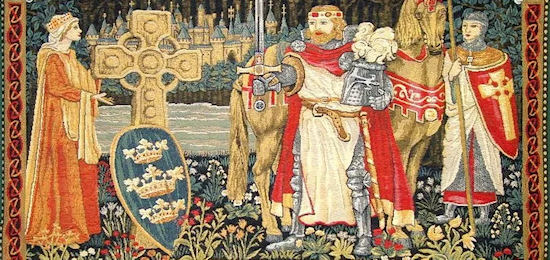The legend of King Arthur is one of the most characteristic myths of medieval England.
Guinevere, Camelot and the Knights of the Round Table compose the romantic medieval setting in which the legendary King is glorified. Perhaps somewhere in the pages of history lies the real face of Arthur, and perhaps his ghost wanders in one of the ruined castles of Wales, the fabulous Camelot or hidden in the fog on Avallon Island.
Let's look for Arthur together, in a time of wars and myths.
The folk tradition
Arthur appears for the first time in a 9th century text. This is the Historia Britonum, attributed to the Welsh monk Nennius. In this text Arthur is presented as a powerful warlord between the 5th and 6th centuries AD, who repels the Saxon invaders. One chapter describes 12 battles led by Arthur the British. The second reference to Arthur is found in the Annales Cambriae (Welsh Chronicle), which also contains chronological data on Arthur's battles. Historians have managed to identify two of the battles (Chester, South Scotland) around 450 AD, but the Chronicles place the last battle (Camlann's Conflict) at 539 AD (or 537 in another sense). This means that Arthur operated over a period of one hundred years, which is unacceptable.
The reason these two texts were mentioned is that together with the oral Welsh tradition, they were the main source of inspiration for Geoffrey of Monmouth (Archdiocese of Oxford) in his own account of Arthur's achievements. Also, Geoffrey's texts were the basis on which later writers (Robert Wace, Layamon) relied to enrich the legend with other elements, such as the quest for the Holy Grail and the Knights of the Round Table. However, there were also writers (Chretien de Troyes, Marie de France) who wrote independently of Geoffrey's stories. In any case, the priest initiated the development of the "Arthurian" literature.
Geoffrey issued in 1133 AD his work Historia Regum Britanniae (History of the Kings of Britain). His begins in the 12th century BC, when, according to a Welsh legend, the island of Britain was colonized by immigrant Trojans led by Brutus, Aeneas' brother, from whom the word "Britain" came from. The book goes on to present the British Kings (including King Lear) whose succession remains unbroken even during the Roman occupation.
After the Romans left Britain (410 AD), Geoffrey presents the events that will lead to Arthur's assumption of power. The departure of the Romans creates a void of power, which Vortigern exploits by seizing the throne from the legal successors (Aurelius Ambrosius, Uther Pendragon). In fact, in order to consolidate his position he calls on Saxon tribes to migrate to Britain in return for their military services. However, Vortigern cannot control the violent and rebellious. Vortigern flees to Wales, where Merlin foresaw his loss.
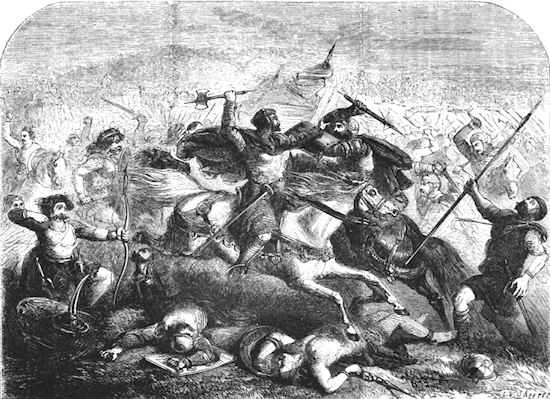 |
Aurelius Ambrosius first assumed power and then Uther Pendragon. Arthur is mentioned as the son of Uther and is presented as a kind of savior from the Saxon whirlwind. According to Geoffrey, Arthur's conception was made at Tintagel's castle when Uther "slept" with Igraine (or Ygraine) after taking the form of her husband, Gorlois, with the help of Merlin. Arthur ascended on the throne in a relatively young age and after overthrowing the Saxons and their allies (Picts and Scots) invaded and conquered the island of Ireland. After a period of peace, during which Arthur marries Guinevere and creates his fort at Caerleon, he invades Gaulle, which he adds to his kingdom. Another period of peace ensues, and Arthur again campaigns in Gaulle to confront the Roman lord Lucius, leaving Mordred, his nephew, on the throne. Arthur dominates Lucius in Burgundy but back in Britain Mordred usurps Arthur's throne and wife. The two opponents fight on the banks of the Camel River in Cornwall with Arthur killing Mordred and getting injured himself. Geoffrey in his story transfers Arthur to the Island of Avalon (Insula Avallonis) to be healed. The name Avalon is probably a paraphrase of the Welsh word "Avallach". According to Geoffrey, his reign lasted for about 25 years. Geoffrey says nothing about Arthur's death, thus adopting a Welsh legend that the King's Return is expected. In another version Arthur died in the battle of Camlann and was buried in Glastonbury Abbey.
Geoffrey is not a historian and we cannot rely entirely on his writings. However, the stories he creates are not entirely fantastic but are based on real events, that he transforms by adding his own elements, changing names and shuffling the sequence of events. He says he draws his information from an old book by Walter, the Archdiocese of Oxford. However, the book is rather fantastic, since Geoffrey, among other things, mentions the presence of Normans in Arthur's army. The Normans appeared in Britain only in the 11th century AD, some 500 years after the time of Arthur.
Geoffrey's narrative contains many fantastic elements, but it is sure to contain historical truths about an important British ruler, whom the popular tradition called Arthur. It is not excluded that this person was also credited with the accomplishments and adventures of multiple British nobles, thus enriching his legend beyond human boundaries. In any case, we should forget about the image of Arthur in shimmering armor, surrounded by iron-cladded knights residing in the mighty and majestic castle of Camelot. These descriptions are best suited to the medieval era of Geoffrey and not to the ravaged Britain of the 5th and 6th centuries AD.
Historical person or myth?
In trying to identify the historical Arthur, it was first necessary to determine the time period in which he was supposed to act. Geoffrey rarely gives dates in his book and these are not always reliable. However, some conclusions can be drawn from the various faces that appear to be contemporary to Arthur. When referring to the Roman Empire it presents a western and an eastern emperor, referring to the period from 395 to 476, when the Western Roman Empire was abolished. Also in the period of Arthur he mentions that the leader of the Eastern Roman Empire was a Leo, probably identified with Leo I (457-474). He also mentions that the Pope in Rome at that time was Sulpicius. Given Geoffrey's tendency to transform names, we can turn to Pope Simplicius (468-483). As for Lucius, that Geoffrey names as the Western Emperor, such a name or a similar one do not exist in the line of succession of the Western Emperors. However, the Sigebert Chronicles of Gembloux mentions an emperor named Lucerius, who ascended to power for only two years (469-470). Geoffrey as a priest could easily have access to this text and get this record (albeit untrue) and in his usual tactic of turning Lucerius into Lucius.
All of the above are mere clues, but there is one well-established fact that comes to support them. In 469-470 the British King camped in Gaulle at the invitation of the Romans. More specifically in 467 Anthemios came to the western throne with the support of Leo I. Anthemios took over Gaulle, largely occupied by the Visigoths, who already controlled the area of present-day Spain. In this effort Anthemios sought the help of the British King (Riothamus), who landed in Gaulle (469-470 AD) with 12,000 troops. For the British there was a very serious reason for taking military action, as British immigrants had settled in the area of Armoric (today Brittany). After some fighting north of the Loire, the British army moved to central Gaulle. However, the Roman provincial governor of Gaulle, Arvandus, tried to bring the Visigoths and Burgundians together to attack the British and divide the whole of Gaulle. The Burgundians remained loyal to the Romans, but the Visigoths decided to move on their own and, after expelling the British in the city of Bourges, defeated them in the battle of Chateauroux. Riothamus entered Burgundy to escape. The retreat line ends in the town of Avallon, a few kilometers south of today's Auxerre. There is no further mention of the fate of Riothamus.
The similarities in this story with Geoffrey's narrative are too many to be a mere coincidence. So if Geoffrey had access to the historical texts about Riothamus (which he probably had) he would have used them and added some fantastic elements to increase Arthur's heroism and epic character.
The main reason that Riothamus was not recognized by scholars as a potential Arthur is, however paradoxical it may seem, his very name. The scholars were looking for someone named Arthur and any other person was rejected. However, a very interesting theory by Professor Fleuriot appeared on the name of Riothamus. According to her, 'Riothamus' is the latin version of the British 'Rigotamos'. The first synthetic rigo- means king and the second -tamo is a superlative suffix. Thus, in free translation "Riothamus" means High King and is a title of office rather than a name.
Apart from Fleuriot's linguistic analysis there are some other facts that suggest his connection with Arthur. One of them is the Roman emperor's desire to form an alliance with him, suggesting that Riothamus had both the stature and the resources to organize a campaign in continental Europe. Moreover, his disappearance near the city of Avallon fits with the mystery surrounding Arthur's fate, which according to Geoffrey and the Welsh legend remains asleep in some crypt until the time of his return. However, there are no sources for Riothamus' action in Britain, so any attempt to link him with the islander Athur is hypothetical. Of course, many of the battles Nennius mentions in Historia Britonum can be placed with relative certainty in the reign of Riothamus.
Other problems arise if we accept that Riothamus and Arthur are the same person. More specifically in the Welsh Chronicles it is reported that Arthur fought the battles of Badon (519 AD) and Camlann (539 AD), where he was wounded and either died or left for Avalon. In Badon, Arthur is alleged to have slaughtered, in a single raid, 960 Saxon after carrying a cross on his back for three days in order to have divine grace. It is clear that there is a long time period from Riothamus disappearance in Burgundy (470 AD) until these battles.
The above inconsistencies can be justified in a variety of ways, but no theory can be proven conclusively. Thus, one possibility is that as soon as Riothamus-Arthur was established as a hero he was credited with the achievements of later kings. Another theory states that there may have been two kings named Arthur. One was certainly Riothamus and the second Arthur a successor to him who fought in the battles of Badon and Camlann. But as the centuries passed and historical memory faded, the two men united into one, the legendary Arthur. A third version is extracted from a Welsh poem, referring to the Battle of Llongborth (near present-day Porchester on the coast of Hampshire) at the end of the 5th century. One turn of the poem refers to the presence of Arthur's army. The following is his English translation:
In Llongborth I saw Arthur's Brave Men who cut with steel, The emperor, ruler in toil of battle
The important thing is that it is not clear if Arthur is involved in the battle. Instead, a military unit called Arthur's men appears. In the last years of the Roman Empire, it was common practice for some select military units to have the name of an important official (eg Theodosians). Likewise Arthur's men may be such a unit, which was preserved even after his death, played a decisive role in the Battle of Badon (where he slaughtered 960 Saxons) and was eventually dismantled at Camlann (539 AD).
The following are some texts of 13th and 14th century chronographers, which refer to Arthur and place him in a specific time frame, thus reinforcing his theory of identification ash Riothamus.
Albericus Trium Fontium (13th century) is trying to give the exact times of hegemony of the British kings of the 5th century, as Geoffrey introduced them in his work. Albericus finds that Arthur ruled for 16 years from 454 to 470. Riothamus, as mentioned above, was lost in 470 upon his retreat to Burgundy.
The "Chronicles of Salzburg" refers to the rise of Hilarus (461 AD) to the pope's office, and then continues with the following phrase: "At that time Arthur, for whom many stories are told, ruled Britain."
Jacques de Guise (late 14th century) in the History of Aene (Hainaut), states that the area was under the control of Arthur and the Huns, Vandals and Goths. The Huns virtually disappeared from the European scene with Attila's death (453 AD). Therefore, a possible parallel reign of Arthur may not be far from that year. In addition Jacques de Guise places Arthur in the same period as Emperor Leo I. One thing Geoffrey does not mention at all is that Arthur is referred to as King of Britain at the time when Roman Aegidius ruled the north of Gaulle. Philippe de Vigneulles, in 1525, refers to a Franco ruler named Childeric, who rose to power in 456 to overthrow Gillon the Roman. Some scholars believe that Gillon may be the French version of Aegidius's name.
Also, John Capgrave, (English chronicler) reports that Arthur ruled from 454 to 470.
All these sources present Arthur as king at approximately the same time (454-470), which means that their sources are common and to some extent independent of Geoffrey. Finally, it is worth mentioning that in the Chronicles of Anjou, the Prince who betrayed Arthur is called Morvandus, a combination of Mordred (Arthur's nephew and usurper of his throne) with Arvandus (Roman governor of Gaulle who betrayed him to the Visigoths).
It is evident that in the quest for identification of the historical Arthur, "maybe" and "probably" are overwhelmingly used. What has been reported so far, cannot be verified using historical data. Arthur is cited by a number of sources in the late 5th and early 6th centuries, but beyond that the historical figure of Arthur is a mystery unsolved based on what we know to date.
However, the only sure thing is that Arthur's legend is still alive and inspiring. It may not even matter in the end if he actually existed or was the creation of extremely imaginative people. The last part of the research presents some locations in Britain that are thought to be related to the birth, life and death of King Arthur.
Looking for traces
The legend of King Arthur is a product of Welsh folk tradition, so the focus is in southwest England, and more specifically in the Cornwall and Somerset area. Of the sources mentioned so far (Geoffrey and later) there are three sites that are directly related to Arthur.
The first is the castle of Tintagel, which is said to have been the place of Arthur’s conception, the fortress of Cadbury, which identifies with Camelot and finally the Glastonbury area. Specifically in Glastonbury there are two places of particular importance, the Glastonbury Abbey and the Glastonbury Tor (= rocky peak). The Abbey is considered Arthur's burial ground, while the Glastonbury Tor is identified with Avalon Island, where Geoffrey says Arthur retired to recover from his injuries after the Battle of Camlann (possible locations near Camelford in Cornwall and on Camel Hill near Cadbury).
In addition to the local folk tradition, which links these places to Arthur, the science of archeology provides significant help through excavations in these areas. The main problems of archaeological research in the discovery of historical Arthur arise, from the very nature of science itself, and from the morphology of the soil in southern Britain. Archeology can rarely confirm the existence of historical figures, except for some tombs, inscriptions or manuscripts that refer to this person. For example, no one can dispute the existance of Philip II, for which in addition to the references of ancient historians, our archaeological research has also revealed his tomb. This is not the case for Arthur. Although the Glastonbury Abbey is considered his burial ground it cannot be scientifically confirmed. This is because 5th and 6th century British customs provided for the body to be buried in a shallow grave and covered with a pile of stones. In addition, Christianity that had already prevailed in Britain banned the burial of sacrifices, as was the case with the tombs of the Pharaohs or the ancient Greeks.
In addition, the geographical terrain of Britain makes research even more difficult. Southern Britain is largely covered by swamps. Rotten vegetation and water are a major problem since they either destroy any artifacts through erosion or displace them from their original location. Objects transported by this procedure are isolated from their previous stratigraphic status and have no value whatsoever for archaeologists. Taking into account that in Arthur's time the main building material was wood, it becomes clear that the research becomes even more difficult. The archaeological findings in the aforementioned areas (Tintagel, Cadbury, Glastonbury) and their connection to the Arthur legend are described below.
Tintagel castle
The castle is on the north coast of Cornwall, and was originally a monastery in the early Christian era. However, archaeological excavations have shown the existence of a fortress. In the summer of 1983 a series of fires on the island of Tintagel revealed the foundations and ruins of a fortified site. From artifacts discovered, the Tintagel story is divided into two periods. The first period covers the entire Roman occupation of Britain. In fact, in the wider area no other artifacts were found, which may be due both to the geographical isolation of the island and to the fact that the Romans had converted Tintagel into a trading station.
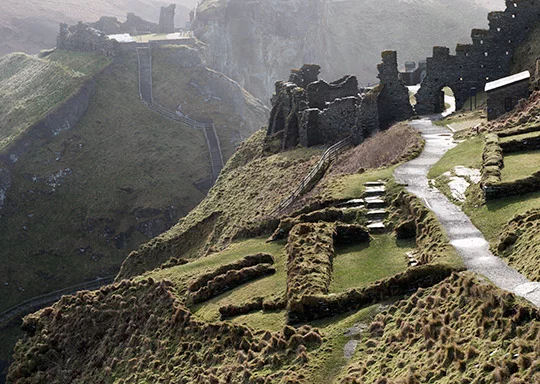 |
The second period extends from the middle of the 5th to the end of the 6th century. During this period there was a plethora of artifacts originating from North Africa, the Eastern Mediterranean and Gaulle, meaning that trade continued after the Romans left. The prevailing theory for Tintagel today is that it was an important fortress, naturally fortified, through which the Romans and its later inhabitants controlled access to the adjacent Camel River. Of course, it is not possible to prove the theory of Arthur's conception and birth of the castle, but the importance of the location for southwestern Britain in the 5th and 6th centuries AD is undisputed.
Cadbury Fort
An important site of Arthur's legend is the castle of Camelot, where Arthur resided with his knights of the Round Table.
However, Camelot is the invention of Chretien de Troyes (12th century) in his short story "Lancelot, le chevalier de la charette". In 1542 John Leland, collector of ancient artifacts on behalf of Henry I, linked the Cadbury hill with the fabulous Camelot, based mainly on the popular tradition of the area.
Excavations at Cadbury in the 1950s and 1970s revealed traces of a fort of about 7 acres. From small objects found (utensils etc.) it was found that the fort was used in the 4th and 5th centuries AD. The fort consisted of four successive bastions. The inner bastion consisted of stone and wood, a style that is found only in Cadbury and no other site in the UK.
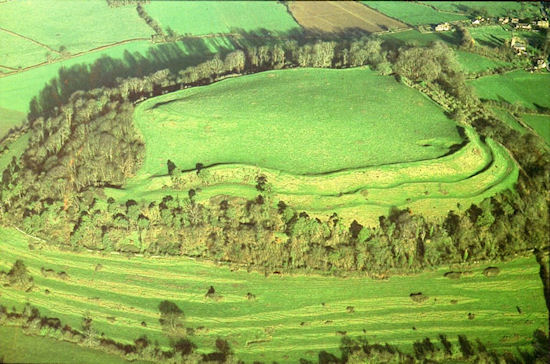 |
The investigation showed that Cadbury was the place of residence of a strong man of the Arthurian period, which is supported by the strong fortification and the large area. Cadbury could accommodate large numbers of soldiers, something Arthur did before the battle in Badon, a few kilometers from Cadbury.
The tradition that links Arthur to Cadbury has survived to this day. Indeed, when archaeologists began excavations, locals asked them if they had come to excavate the King.
Glastonbury
The last sites associated with Arthur are in Glastonbury and more specifically the Abbey.
There is supposed to be the Arthur's Tomb and the Glastonbury Tor, one of the four hills surrounding Glastonbury, which is thought to have been the basis for the creation of the legend of the Avalon Island, where Arthur remains asleep. The word Avalon in one version is derived from the Welsh avallach, which means "Place of apples", while in another version it comes from the Celtic word Ynys-witrin (Caradoc of Llancarfan), which means Glass Island. In the past, the area around Glastonbury Tor was flooded with an adjoining river flood, giving Tor the impression of an island. In 1960 Geoffrey Russel observed the remains of an ancient trail, which went up to the top of the hill. The construction of the trail dates back to about the 3rd century BC and seems to have served ritual purposes of the ancient Celtic religion, which seems to explain why the hill is considered by the locals, even today, to be enchanted.
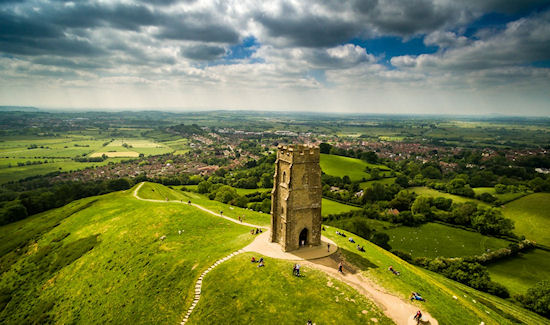 |
For those who follow the version of the legend that Arthur died in the Battle of Camlann, the Glastonbury Abbey is a sacred place of pilgrimage. In 1191 the Abbey monks claimed to have discovered the tomb of Arthur. Above the tombstone there was a cross bearing the Latin inscription:
Hic iacet sepultus inclitus rex Arturius in insula Avalonia
Here lies the famous King Arthur on the Avalon Island
In 1278 Henry II ordered that the tomb be opened. Two skeletons were found inside, a man and a woman. The bones were transported to the Abbey church but later mysteriously disappeared along with the cross. In 1607 William Camden published a drawing of the cross, which he said was owned by a clergyman in Wales. However, since the cross was not found, Camden was considered unreliable.
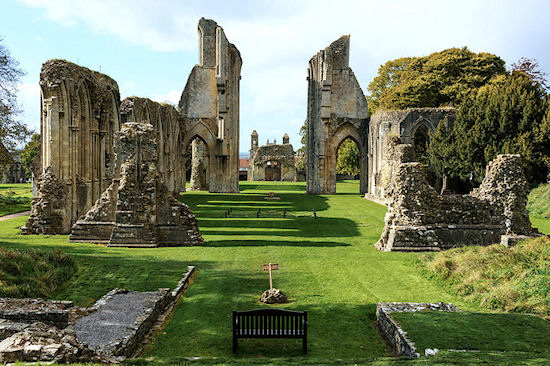 |
In 1958 Ralegh Radford searched for the tomb but was unable to find anything to prove the monks' claim. Many historians believe that the "discovery" of Arthur's tomb was a deliberate fraud by the monks in order to raise money for the reconstruction of the Abbey, which was destroyed by fire in 1184.
It seems that archaeological excavations and the study of historical texts gave no answers and evidence about Arthur and it is doubtful whether they will manage to do so in the future. King Arthur will remain in the fog of Avalon waiting for time to pass until his return.




